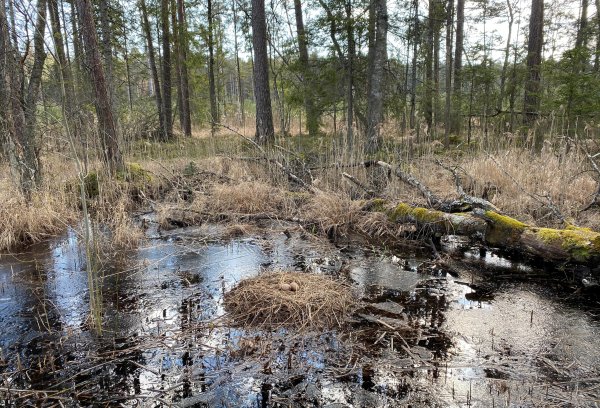LVM Forester Spots a Crane`s Nest in a Pine Young Stand
While surveying young stands in Venta Forest District in LVM Ziemeļkurzeme Region, JSC “Latvia’s State Forests” (LVM) forester noticed a crane`s nest with eggs in a wet lowland. There are no activities happening in this area, because it is a territory of natural values.
“I noticed the nest in a 7-year-old pine young stand. In the process of a renewal felling, big trees around the lowland were preserved. And as we can see – the crane has recognized this area as a suitable place for nesting and laying eggs,” says Jānis Brauns, LVM Forester.
The number of cranes in Latvia grows year by year; we have 1000 to 2500 couples currently nesting here.
“If once it was considered that cranes nested only in swamps, then now the majority of the population nest in very wet forests – both deep in a forest and on firebreaks, glades and in young stands, also in beaver activity areas,” tells Mārtiņš Kalniņš, LVM Environment Planning Expert.
Having noticed a human being or predator, crane gets up from its nest, and, bent down, goes away at a safe distance from the nest. Then it starts to cry, trying to lure off the potential enemy. Most often cranes have two babies, less frequently - three. Babies learn to run relatively early; however, initially they avoid enemies, by hiding and freezing. In the second half of summer, cranes with their babies can relatively often be spotted in fields, meadows and pastures.
Cranes are monogamous birds – settled couples stay together; however, if one bird dies, then the other bird finds a new partner. Cranes are not picky in terms of food. Although cranes do eat cranberries, these birds are considered omnivore – they eat berries, parts of fruit, seeds, insects and other invertebrates, frogs, reptiles, small mammals (rodents). In the second half of summer and in autumn, cranes gather in groups and often feed in fields, picking up any spilled grains.
There are 15 known crane species in the world, of which only one can be found in Latvia – the common crane that can be seen from March till October. But the earliest spring migrants have been observed already in February. Quite many bird observations have also been recorded from November till January.
In order to improve long-term protection and maintenance of identified protected habitats and species, LVM provides maintenance and restoration work for protected species and habitats. In commercial forests during the bird breeding season (1 April - 30 June) tending of young stands is not carried out in up to 10-year-old pine and deciduous tree stands and in up to 30-year-old spruce stands, except in areas where coniferous tree height does not exceed 0.7 metres, and the height of deciduous trees is less than 1 metre. In spring and summer, tending of young forest stands is not carried out in micro-reserves and their buffer zones intended for bird protection, in specially protected natural areas, water and marsh protection zones.



